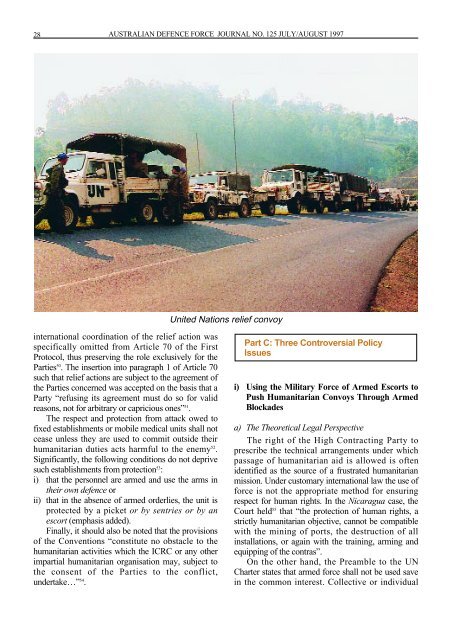ISSUE 125 : Jul/Aug - 1997 - Australian Defence Force Journal
ISSUE 125 : Jul/Aug - 1997 - Australian Defence Force Journal
ISSUE 125 : Jul/Aug - 1997 - Australian Defence Force Journal
You also want an ePaper? Increase the reach of your titles
YUMPU automatically turns print PDFs into web optimized ePapers that Google loves.
28AUSTRALIAN DEFENCE FORCE JOURNAL NO. <strong>125</strong> JULY/AUGUST <strong>1997</strong>United Nations relief convoyinternational coordination of the relief action wasspecifically omitted from Article 70 of the FirstProtocol, thus preserving the role exclusively for theParties 50 . The insertion into paragraph 1 of Article 70such that relief actions are subject to the agreement ofthe Parties concerned was accepted on the basis that aParty “refusing its agreement must do so for validreasons, not for arbitrary or capricious ones” 51 .The respect and protection from attack owed tofixed establishments or mobile medical units shall notcease unless they are used to commit outside theirhumanitarian duties acts harmful to the enemy 52 .Significantly, the following conditions do not deprivesuch establishments from protection 53 :i) that the personnel are armed and use the arms intheir own defence orii) that in the absence of armed orderlies, the unit isprotected by a picket or by sentries or by anescort (emphasis added).Finally, it should also be noted that the provisionsof the Conventions “constitute no obstacle to thehumanitarian activities which the ICRC or any otherimpartial humanitarian organisation may, subject tothe consent of the Parties to the conflict,undertake…” 54 .Part C: Three Controversial PolicyIssuesi) Using the Military <strong>Force</strong> of Armed Escorts toPush Humanitarian Convoys Through ArmedBlockadesa) The Theoretical Legal PerspectiveThe right of the High Contracting Party toprescribe the technical arrangements under whichpassage of humanitarian aid is allowed is oftenidentified as the source of a frustrated humanitarianmission. Under customary international law the use offorce is not the appropriate method for ensuringrespect for human rights. In the Nicaragua case, theCourt held 55 that “the protection of human rights, astrictly humanitarian objective, cannot be compatiblewith the mining of ports, the destruction of allinstallations, or again with the training, arming andequipping of the contras”.On the other hand, the Preamble to the UNCharter states that armed force shall not be used savein the common interest. Collective or individual
















